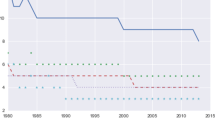Abstract
According to the increasing importance of advanced technologies for economy growth and the incremental complexity of research and development management, a novel methodology is proposed in this paper to monitor the evolution trace of innovation sources. This approach focuses on the knowledge-transfer among technologies using patent cluster analysis. More specifically, a citation network model, consisting of patents in “Coherent Light Generators” classification, is established with the data collected from the United States Patent and Trademark Office. In addition, dynamical topological structure is investigated to probe into the overview properties and identify key milestones for the expanding citation network from 1976 to 2014. Next, a novel framework for patent clustering is developed to find out knowledge chunks of which internal knowledge-flows are dense while cut edges are sparse. Community detection algorithms are compared with different assessment indices based on citation network and the selected solution is improved using optimization objectives of cluster analysis. Then, the dynamical structure of the detected knowledge chunks is investigated and the evolution of innovation sources, identified by k-core decomposition, is monitored to unveil the technology development trace. Finally, analysis results are discussed and related conclusions are summarized. This article improves approaches for patent cluster analysis and develops a new follow-up investigation methodology for detected knowledge chunks. It is discovered there are not only scale increases, but also the integration for knowledge chunks during the focal period. Identifying the knowledge chunks which obtain rapid growth in both cluster scale and innovation source is useful to detect technology development opportunities.



















Similar content being viewed by others
References
Ahn, Y.-Y., Bagrow, J. P., & Lehmann, S. (2010). Link communities reveal multiscale complexity in networks. Nature, 446(7136), 664–667.
Albert, R., & Barabasi, A.-L. (2002). Statistical mechanics of complex network. Reviews of Modern Physics, 74(1), 47–97.
Barabasi, A.-L., & Albert, R. (1999). Emergence of scaling in random networks. Science, 286(5439), 509–512.
Blaj, G., Calagiulo, P., Carini, G., et al. (2015). X-ray detectors at the linac coherent light source. Journal of Synchrotron Radiation, 22(3), 577–583.
Blondel, V. D., Guillaume, J. L., Lambiotte, R., et al. (2008). Fast unfolding of community in large networks. Journal of Statistical Mechanics: Theory and Experiment, 2008(10), 155–168.
Chang, S. (2012). Using patent analysis to establish technological position: Two different strategic approaches. Technological Forecasting and Social Change, 79(1), 3–15.
Chang, S., Lai, K., & Chang, S. (2009). Exploring technology diffusion and classification of business methods: Using the patent citation network. Technological Forecasting and Social Change, 76(1), 107–117.
Chang, P., Wu, C., & Leu, H. (2010). Using patent analyses to monitor the technological trends in an emerging field of technology: A case of carbon nanotube field emission display. Scientometrics, 82(1), 5–19.
Chen, D., Fu, Y., & Shang, M. (2009). A fast and efficient heuristic algorithm for detecting community structures in complex networks. Physica A, 388(13), 2741–2749.
Cheng, Q., Liu, Z., Huang, J., et al. (2016). Community detection in hypernetwork via Density-Ordered Tree partition. Applied Mathematics and Computation, 276(C), 384–393.
Clauset, A., Newman, M. E. J., & Moore, C. (2004). Finding community structure in very large networks. Physical Review E, 70(6), 066111.
Comin, D. A., & Mestieri, M. (2013). Technology diffusion: Measurement, causes and consequences. Institute for New Economic Thinking (INET), 2, 565–622.
Erdi, P., Makovi, K., Somogyvari, Z., et al. (2013). Prediction of emerging technologies based on analysis of the US patent citation network. Scientometrics, 95(1), 225–242.
Fortunato, S., & Barthelemy, M. (2007). Resolution limit in community detection. Proceedings of the National Academy of Science, 104(1), 36–41.
Fortunato, S., Latora, V., & Marchiori, M. (2004). A method to find community structures based on information centrality. Physical Review E, 70(5), 148–168.
Georgiadis, D. R., Mazzuchi, T. A., & Sarkani, S. (2013). Using multi criteria decision making in analysis of alternatives for selection of enabling technology. Systems Engineering, 16(3), 287–303.
Girvan, M., & Newman, M. E. J. (2002). Community structure in social and biological networks. Proceedings of the National Academy of Science, 99(12), 7821–7826.
Gress, B. (2010). Properties of the USPTO patent citation network: 1963–2002. World Patent Information, 32(1), 3–21.
Jun, S., Park, S. S., & Jang, D. S. (2012). Technology forecasting using matrix map and patent clustering. Industrial Management & Data Systems, 112(5), 786–807.
Karlsson, M. (2014). Four-dimensional rotations in coherent optical communications. Journal of Lightwave Technology, 32(6), 1246–1257.
Kim, B., Gazzola, G., Lee, J., et al. (2014a). Inter-cluster connectivity analysis for technology opportunity discovery. Scientometrics, 98(1), 1811–1825.
Kim, E., Cho, Y., & Kim, W. (2014b). Dynamic patterns of technological convergence in printed electronics technologies: Patent citation network. Scientometrics, 98(2), 975–998.
Kirby, M. R. (2001). A methodology for technology identification, evaluation, and selection in conceptual and preliminary aircraft design. PhD Thesis, Atlanta: School of Aerospace Engineering, Georgia Institute of Technology.
Kitsak, M., Gallos, L. K., Havlin, S., et al. (2010). Identification of influential spreaders in complex networks. Nature Physics, 6(11), 888–893.
Latapy, M., & Pons, P. (2004). Computing communities in large networks using random walks. Journal of Graph Algorithms and Application, 10(2), 284–293.
Lee, H., Kim, C., Cho, H., et al. (2009). An ANP-based technology network for identification of core technologies: A case of telecommunication technologies. Expert Systems with Applications, 36(1), 894–908.
Leicht, E. A., & Newman, M. E. J. (2007). Community structure in directed networks. Physical Review E, 100(11), 2339–2340.
Leskovec, J., Lang, K. J., Dasgupta, A., et al. (2008). Community structure in large networks: Natural cluster sizes and the absence of large well-defined clusters. Internet Mathematics, 6(1), 29–123.
Minitti, M. P., Robinson, J. S., Coffee, R. N., et al. (2015). Optical laser systems at the linac coherent light source. Journal of Synchrotron Radiation, 22(3), 526–531.
Newman, M. E. J. (2004a). Detecting community structure in networks. The European Physics Journal B, 38(2), 321–330.
Newman, M. E. J. (2004b). Fast algorithm for detecting community structure in networks. Physical Review E, 69(6), 066133.
Newman, M. E. J. (2006a). Finding community structure in networks using the eigenvectors of matrices. Physical Review E, 74(3), 036104.
Newman, M. E. J. (2006b). Modularity and community structure in networks. Proceedings of the National Academy of Science, 103(23), 8577–8582.
Newman, M. E. J. (2013). Spectral methods for network community detection and graph partitioning. Physical Review E, 88(4), 042822.
Raghavan, U. N., Albert, R., & Kumara, S. (2007). Near linear time algorithm to detect community structures in large-scale networks. Physical Review E, 76(3), 036106.
Rodriguez, A., Kim, B., Turkoz, M., et al. (2015). New multi-stage similarity measure for calculation of pairwise patent similarity in a patent citation network. Scientometrics, 103(2), 565–581.
Tseng, Y., Lin, C., & Lin, Y. (2007). Text mining techniques for patent analysis. Information Processing and Management, 43(5), 1216–1247.
Wang, X., Zhao, Y., Liu, R., et al. (2013). Knowledge-transfer analysis based on co-citation clustering. Scientometrics, 97(3), 859–869.
Watts, D. J., & Strogatz, S. H. (1998). Collective dynamics of ‘small-world’ networks. Nature, 393, 409–410.
Wuchty, S., Jones, B. F., & Uzzi, B. (2007). The increasing dominance of teams in production of knowledge. Science, 316(5827), 1036–1039.
Yoon, J., & Kim, K. (2012). Detecting signals of new technological opportunities using semantic patent analysis and outlier detection. Scientometrics, 90(2), 445–461.
Yoon, J., Park, H., & Kim, K. (2013). Identifying technological competition trends for R&D planning using dynamic patent maps: SAO-based content analysis. Scientometrics, 94(1), 313–331.
You, H., Li, M., Hipel, K. W., et al. (2017). Development trend forecasting for coherent light generator technology based on patent citation network analysis. Scientometrics. doi:10.1007/s11192-017-2252-y.
You, H., Li, M., Jiang, J., et al. (2014). A network modeling and structure optimization approach for technology system of systems. Journal of National University of Defense Technology, 6, 123–127.
Zhou, H. (2003). Distance, dissimilarity index, and network community structure. Physical Review E, 67(6), 891–901.
Acknowledgements
The authors are grateful to the anonymous referees who provided thoughtful comments, and also would like to thank Prof. Keith W. Hipel at the University of Waterloo for his constructive suggestions in improving the quality of this paper. This work was supported partly by the National Science Foundation of China under Grant No. 71501182 and No. 71671186 and the Research Project of National University of Defense Technology under Grand No. JS16-03-08.
Author information
Authors and Affiliations
Corresponding author
Rights and permissions
About this article
Cite this article
You, H., Li, M., Jiang, J. et al. Evolution monitoring for innovation sources using patent cluster analysis. Scientometrics 111, 693–715 (2017). https://doi.org/10.1007/s11192-017-2318-x
Received:
Published:
Issue Date:
DOI: https://doi.org/10.1007/s11192-017-2318-x




